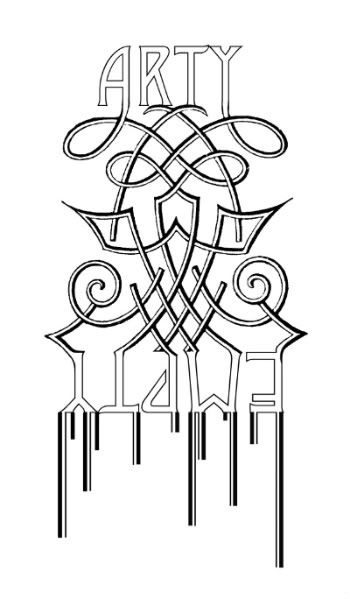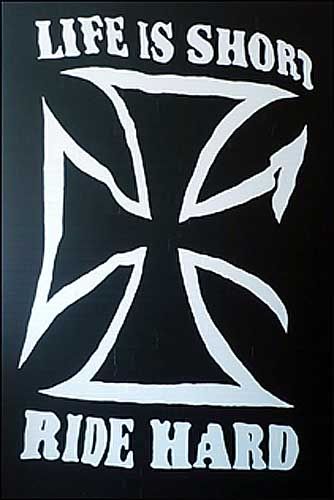Pas besoin d’être un motard aguerri pour le savoir. Il suffit d’ouvrir les yeux et faire confiance au fameux « inconscient collectif » (déjà que l’inconscient personnel est dur à localiser...). Chevaucher une Triumph 6T Thunderbird de 1950 (celle de Brando dans L’équipée Sauvage) ou plus communément encore une bonne vieille Harley-Davidson, et prendre la route sur une Suzuki Hayabusa GSX 1300 R, disons modèle plus sportif, ne renvoie pas du tout à la même imagerie ni aux mêmes sensations. Il en est de même pour les expositions simultanées d’Oliver Millagou et d’Aaron Young.
Pourtant les deux artistes utilisent la moto et son univers décadent pour réinterpréter, chacun à leur manière, les codes et signes balisés de cette « culture populaire » (autre poncif populaire / élitiste : qui a-t-il de populaire à connaître les caractéristiques du bicylindre en V culbuté à 45° cher aux Harley ?...ou l’élitisme de Picasso et les Maîtres....). A vrai dire, et pour résumé (comme ça vous n’êtes pas obligé de finir de lire cet article), il y a entre le français Millagou et l’américain Young, la même différence culturelle qu’entre les deux traductions du titre du film de Jack Cardiff de 1967 : Naked under leather devient.... La motocyclette. Rien à ajouter.
Disons plutôt qu’Olivier Millagou s’assoit dans le side-car. Un peu passif, préférant regarder le paysage. L’exposition Chapter 2 19 M.C. chez Baumet Sultana jusqu’au 14 mai joue la carte du total look, de la porte en bois brûlés aux murs orange. A trop vouloir jouer sur les clichés, on finit par tomber dedans. Enlevons d’emblée toute ambiguïté : Millagou est un bon (et encore jeune) artiste français, ses Draw Pins, ses bois gravés et travaillés (Disco Rising), ses cartes postales subtiles, construisent un travail sérieux et pertinent, décalé et maîtrisé. Il n’empêche, son exposition personnelle actuelle n’est pas très bonne. Les gilets peints (Road Painting) sont franchement légers (même au printemps), trop de signe tuant le signe. Les One percent paintings, matériaux détournés (laque et gaffeur) et écriture corporellement sculptée sont plutôt réussies même si là encore Millagou ne creuse peut-être pas assez son concept pour s’arrêter un peu tôt une fois la route de l’esthétique atteinte. Idem pour les diapositives.... Millagou semble avoir choisi de prendre la route, l’envolée sauvage, sans avoir fait le plein.... nous fait-il le coup de la panne ?
Cela ne veut pas dire que l’exposition Introducing d’Aaron Young à la galerie Almine Rech, jusqu’au 20 mai, carbure au super. En effet, les barrières métalliques écrasées et plongées dans l’or 24 carats, comme la peinture jeu-illusion d’optique du Christ sont parfaitement dispensables : la première pour son insuffisance (il faudrait un jour se pencher sur le changement de matériau pauvre / noble et comprendre que cela ne sert (plus) à rien, désormais...), le second pour son... insuffisance (le côté blague internet ne doit pas être confondu avec la peinture comme illusion). Par contre, les Punchlines, le magnifique tag sur le miroir, effacé et efficace (Young est un artiste qui utilise à merveille la citation scripturale) sont deux exemples réussis de la force du travail d’Aaron Young, mélange de sobriété et de puissance qui gronde. Grondent justement les deux peintures, oeuvres maîtresses de l’expo et tirées de sa performance motorisée de la dernière biennale du Whitney (bien que reprise de tentatives antérieures). Young fait tourner des motos, effectuant des « burns » sur des plaques de bois apprêtées de peintures préalables et découvertes par les brûlures du pneu. Certes, faire du Pollock aléatoire n’est pas franchement nouveau, mais le résultat (cette fois) est convaincant. Tout d’abord parce que le résultat visuel est impressionnant, mélange de picturalité avec les jeux de matières et de traitements à la surface de la « toile » et composition fondant l’acier, le caoutchouc et l’acrylique. Ensuite et surtout dans la remise en question intelligente du statut d’oeuvre d’art. Que reste-t-il à vendre ? Les tableaux deviennent-ils des oeuvres à part entière, acquérant un nouveau statut de par leur partition ou demeurent-ils des résidus de performance, se ralliant ainsi aux « trophées » de l’art conceptuel ? La segmentation opérée a posteriori définit l’intervention de l’artiste dont le geste final fracture et annihile l’unicité de l’oeuvre. Entre expressionnisme abstrait, minimalisme de la trace, concept et performance, Aaron Young redéfinit avec élégance le regard porté sur l’oeuvre et transgresse allégrement les frontières et les règles... comme un vrai biker finalement.
Alors, que vous vous choisissiez les autoroutes (embouteillées) de l’Ouest sauvage calé derrière Millagou ou que vous jouiez les hors-la-loi (version tuning) aux côtés de Young, n’oubliez pas de mettre votre casque. L’art est un passe-temps dangereux pour les têtes fragiles...
Millagou Vs. Young: Black Rebels Motorcycle Club
No need to be a die-hard biker to know that. You only have to open your eyes and trust the famous “collective unconscious” (the “personal unconscious” is still hard to find…). Sit astride a Triumph 6T 1950 Thunderbird (Brando’s one on The Wild One) or a more commonly old Harley-Davidson, and take the road with a Suzuki Hayabusa GSX 1300R, a more sportive model, do not refer to the same imagery or feelings. It’s exactly the same concerning the simultaneous exhibitions of Oliver Millagou and Aaron Young.
Well, both artists use motorcycle and its decadent environment to reinterpret, on their own way, codes and blazed signs of this “popular culture” (an other commonplace: low/high culture: what’s popular to know the characteristics of the 45 degree V-Twin engine of Harley?... or the high culture of Picasso and the Masters exhibition?). To be honest, and to sum up (so, you don’t have to read entirely this article), the difference between the French Millagou and the American Young is the same between the translation of the title of Jack Cardiff’s movie on 1967: Naked under leather became… The motorcycle. Nothing to add.
More precisely, let’s say that Millagou seats down on the sidecar. A little bit passive, looking at the landscape. The exhibition Chapter 2 19 M.C. at Baumet Sultana Gallery, Paris, until May 14, 2009 plays the total look, from the burned door to orange walls. When you play too much with clichés, you fall into. Don’t be ambiguous: Millagou is a good (and still young) French artist, his Draw Pins, his carved and worked woods (Disco Rising), his subtle postcards, make a relevant and serious work, unusual and mastered. The fact remains that his last exhibition is not good. Painted vests (Road Painting) are clearly light (even on Spring), too much signs kill signs. The One Percent Paintings, embezzled materials (enamel and scotch tape) and bodily sculpted writings are almost successful even if Millagou, one more time, does not go into his concept in depth and stops too early, once he reached the aesthetical road. It’s the same for the slides… Millagou seems to have chosen to take the road, the wild one, without tanking up… Does he try the old fake “car’s broken down” routine?
It does not imply that the exhibition Introducing Aaron Young at Almine Rech Gallery, until May 20, works fine. Indeed, the smashed and 24-carat gold covered metallic fences, or the optical illusion stuff painting of the Christ, are totally dispensable: the first ones for their insufficiency (we’ll speak one day about the poor/noble materials changing and understand that it’s no more useful now…), the second one for its… insufficiency (the Internet joke style is not equivalent to painting as illusion). On the contrary, the Punchlines, the beautiful tag on the mirror, erased and efficient (Young perfectly uses the scriptural quotations), are two examples of the strength of the work of Aaron Young, mixing soberness and roaring power. Roaring are his two paintings, masterpieces of the exhibition, extracted from his last motorized Whitney Biennale performance (even if he already tried it). Young asked motorcycles to turn, making “burns” on beforehand paint priming wood panels discovered by tires burning. That’s true, playing to be Pollock is not really innovative but the result is, this time, convincing. Firstly because the visual result is impressive, mixing pictorial effects with materials and treatments changes on the surface of the “canvases”, the composition melts down steel, rubber and acrylic paint. Secondly and precisely because it cleverly questions the status of the work of art. What remains to sell? Are the paintings turning into specific works, acquiring a new dimension by their split or do they stay performance residues, near of conceptual art trophies? The segmentation post operated defines the artist intervention, his final gesture fracturing and annihilating the uniqueness of the piece. Between abstract expressionism, trace minimalism, concept and performance, Aaron Young elegantly redefines the way you look on artworks and joyfully breaks rules and frontiers… like a real biker, right?
So, if you choose the freeways (in a jam) of American Wild West, chocked behind Millagou or if you play outlaws (tuning version) side by side with Young, don’t forget to put a helmet on. Art is a dangerous time-killer for fragile heads…



Aucun commentaire:
Enregistrer un commentaire